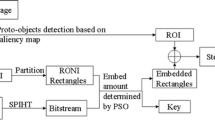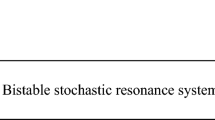Abstract
The noise always plays a key role in different science and engineering applications. Here, we study the effect of the addition of external noise (i.e., stochastic resonance (SR) noise) in weak signal detection application. We also explore the conditions of improvability and non-improvability for a particular SR noise. We analyze both symmetric and asymmetric SR noises in our example. With certain equality and inequality constraints, we discuss the penalty function method which is used to design a single objective function. Furthermore, the particle swarm optimization technique has been used to maximize the probability of detection (\(P_\mathrm{D}\)) at a constant value of the probability of false alarm (\(P_\mathrm{FA}\)). With a numerical example, we have exhibited the performance of the proposed detector. We compare our proposed detection technique with the state-of-the-art techniques, and it is observed that the optimum \(P_\mathrm{D}\) is comparable at a constant value of \(P_\mathrm{FA}\). The proposed detection technique is also used for watermark detection application to show the practicality of the proposed technique.










Similar content being viewed by others
References
M. Anitescu, On solving mathematical programs with complementarity constraints as nonlinear programs. Preprint ANL/MCS-P864-1200, Argonne National Laboratory, Argonne, IL, vol. 3 (2000)
M. Anitescu, Global convergence of an elastic mode approach for a class of mathematical programs with complementarity constraints. SIAM J. Optim. 16, 120–145 (2005)
M. Bell, Y. Kochman, On composite binary hypothesis testing with training data, in Fifty-Fifth Annual Allerton Conference, pp. 1026–1033 (2017)
H.Y. Benson, A. Sen, D.F. Shanno, R.J. Vanderbei, Interior-point algorithms, penalty methods and equilibrium problems. Comput. Optim. Appl. 34, 155–182 (2006)
D.P. Bertsekas, Constrained Optimization and Lagrange Multiplier Methods (Academic press, Cambridge, 1982)
E.G. Birgin, J.M. Martínez, Practical augmented Lagrangian methods for constrained optimization, in Society for Industrial and Applied Mathematics (SIAM) (2014). https://doi.org/10.1137/1.9781611973365
S. Boyd, L. Vandenberghe, Convex Optimization (Cambridge University Press, Cambridge, 2004)
R.H. Byrd, N.I.M. Gould, J. Nocedal, R.A. Waltz, An algorithm for non-linear optimization using linear programming and equality constrained sub-problems. Math. Program. 100, 27–48 (2004)
R.H. Byrd, J. Nocedal, R.A. Waltz, Steering Exact Penalty Methods for Optimization Optimization Technology Center, Northwestern University, Evanston, IL, USA, Tech. 60208 (2006)
H. Chen, P.K. Varshney, S.M. Kay, J.H. Michels, Theory of stochastic resonance effects in signal detection: part I-fixed detectors. IEEE Trans. Signal Process. 55, 3172–3184 (2007)
H. Chen, P.K. Varshney, J.H. Michels, Denoising noisy images with noise, in Forty-First Asilomar Conference on Signal, Systems, and Computers, pp. 513–517 (2007)
L. Chen, D. Goldfarb, Interior-point \({\mathscr {L}}\)2 penalty methods for nonlinear programming with strong global convergence properties, in Mathematical Programming, vol 108 (Springer, 2006), pp. 1–36
R. Chouhan, R.K. Jha, P.K. Biswas, Enhancement of dark and low contrast images using dynamic stochastic resonance. IET Image Process. 7, 174–184 (2013)
J.J. Collins, C.C. Chow, T.T. Imhoff, Stochastic resonance without tuning. Nature 376, 236–238 (1995)
I.J. Cox, J. Kilian, F.T. Leighton, T. Shamoon, Secure spread spectrum watermarking for multimedia. IEEE Trans. Image Process. 6, 1673–1687 (1997)
X.J. Dong, A.J. Yan, Stochastic resonance in a linear static system driven by correlated multiplicative and additive noises. Appl. Math. Model. 38, 2915–2921 (2014)
J.K. Douglass, L. Wilkens, E. Pantazelou, F. Moss, Noise enhancement of information transfer in crayfish mechanoreceptors by stochastic resonance. Nature 365, 337–340 (1993)
E. Elbeltagi, T. Hegazy, D. Grierson, Comparison among five evolutionary-based optimization algorithms. Adv. Eng. Inf. 19, 43–53 (2005)
L. Gammaitoni, P. Hänggi, P. Jung, F. Marchesoni, Stochastic resonance. Rev. Mod. Phys. 70, 223 (1998)
P.P. Gandhi, V. Ramamurti, Neural networks for signal detection in non-Gaussian noise. IEEE Trans. Signal Process. 45, 2846–2851 (1997)
P.E. Gill, W. Murray, M.A. Saunders, SNOPT: an SQP algorithm for large-scale constrained optimization. SIAM Rev. 47, 99–131 (2005)
N.I.M. Gould, D. Orban, P.L. Toint, An interior-point \({\mathscr {L}}\)1-penalty method for nonlinear optimization (Technical Report). Rutherford Appleton Laboratory (2003)
G. Guo, M. Mandal, Y. Jing, A robust detector of known signal in non-Gaussian noise using threshold system. Signal Process. 92, 2676–2688 (2012)
G. Guo, M. Mandal, Y. Jing, Optimal design of noise-enhanced binary threshold detector under AUC measure. IEEE Signal Process. Lett. 20, 161–164 (2013)
N. Halay, K. Todros, A.O. Hero, Binary hypothesis testing via measure transformed quasi-likelihood ratio test. IEEE Trans. Signal Process. 65, 6381–6396 (2017)
G.P. Harmer, B.R. Davis, D. Abbott, A review of stochastic resonance: Circuits and measurement. IEEE Trans. Instrum. Meas. 51, 299–309 (2002)
R. Hassan, B. Cohanim, O. De Weck, G. Venter, A comparison of particle swarm optimization and the genetic algorithm, in 46th AIAA/ASME/ASCE/AHS/ASC Structures, Structural Dynamics (2005)
Q. He, J. Wang, Effects of multiscale noise tuning on stochastic resonance for weak signal detection. Digit. Signal Process. 22, 614–621 (2012)
A. Histace, D. Rousseau, Constructive action of noise for impulsive noise removal in scalar images. IEEE Electron. Lett. 42, 393–395 (2006)
M.-O. Hongler, Y.L. Meneses, A. Beyeler, J. Jacot, The resonant retina: exploiting vibration noise to optimally detect edges in an image. IEEE Trans. Pattern Anal. Mach. Intell. 25, 1051–1062 (2003)
X.M. Hu, D. Ralph, Convergence of a penalty method for mathematical programming with complementarity constraints. J. Optim. Theory Appl. 123, 365–390 (2004)
R.K. Jha, R. Chouhan, K. Aizawa, P.K. Biswas, Dark and low-contrast image enhancement using dynamic stochastic resonance in discrete cosine transform domain. APSIPA Trans. Signal Inf. Process. 2, 1–18 (2013)
R.K. Jha, R. Chouhan, Noise induced contrast enhancement using stochastic resonance on singular values. Signal Image Video Process. 8, 339–347 (2014)
R.K. Jha, R. Chouhan, Dynamic stochastic resonance-based grayscale logo extraction technique in combined SVD-DCT domain. J. Frankl. Inst. 351, 2938–2965 (2014)
Y. Jiang, S. Yin, Recent results on key performance indicator oriented fault detection using the DB-KIT toolbox, in Industrial Electronics Society, Annual Conference of the IEEE, pp. 7103–7108 (2017)
Y. Jiang, N. Zhao, Z. Yin, H. Yu, Study on recent developments of residual generation design approach based on available process measurements, in International Conference on Industrial Technology (ICIT), pp. 973–978 (2016)
N.F. Johnson, S. Jadodia, Exploring steganography: seeing the unseen. IEEE Comput. 31, 26–34 (1998)
S. Kay, Can detectability be improved by adding noise? IEEE Signal Process. Lett. 7, 8–10 (2000)
O. Krishna, R.K. Jha, A.K. Tiwari, B. Soni, Noise induced segmentation of noisy color image, in NCC, pp. 1–5 (2013)
B. Kosko, Noise (Penguin, London, 2006)
I. Lee, X. Liu, C. Zhou, B. Kosko, Noise-enhanced detection of subthreshold signals with carbon nanotubes. IEEE Trans. Nanotechnol. 5, 613–627 (2006)
J.E. Levin, J.P. Miller, Broadband neural encoding in the cricket cercal sensory system enhanced by stochastic resonance. Nature 380, 165–168 (1996)
S. Leyffer, G. López-Calva, J. Nocedal, Interior methods for mathematical programs with complementarity constraints. SIAM J. Optim. 17, 52–77 (2006)
H. Li, J. Bi, Y. Shen, Propagation and enhancement of the noise-induced signal in a coupled cell system. Appl. Math. Model. 35, 2682–2687 (2011)
Y. Li, R. Song, W. Wang, Particle swarm optimization of compression measurement for signal detection. Circuits, Syst. Signal Process. 31, 1109–1126 (2012)
S. Liu, T. Yang, X. Zhang, X. Hu, L. Xu, Noise enhanced binary hypothesis-testing in a new framework. Digit. Signal Process. 41, 22–31 (2015)
B. McNamara, K. Wiesenfeld, Theory of stochastic resonance. Phys. Rev. A 39, 4854 (1989)
S. Mitaim, B. Kosko, Adaptive stochastic resonance. Proc. IEEE 86, 2152–2183 (1998)
M. Mongeau, A. Sartenaer, Automatic decrease of the penalty parameter in exact penalty function methods. Eur. J. Oper. Res. 83, 686–699 (1995)
F. Moss, F. Chiou-Tan, F.R. Klinke, Will there be noise in their ears? Nat. Med. 2, 860–862 (1996)
M. Naderpour, A. Ghobadzadeh, A. Tadaion, S. Gazor, Generalized Wald test for binary composite hypothesis test. IEEE Signal Process. Lett. 22, 2239–2243 (2015)
A. Patel, B. Kosko, Stochastic resonance in noisy spiking retinal and sensory neuron models. Neural Netw. 18, 467–478 (2005)
A. Patel, B. Kosko, Optimal noise benefits in Neyman–Pearson and inequality-constrained statistical signal detection. IEEE Trans. Signal Process. 57, 1655–1669 (2009)
C.I. Podilchuk, E.J. Delp, Digital watermarking: algorithms and applications. IEEE Signal Process. Mag. 18, 33–46 (2001)
Y. Rahmat-Samii, D. Gies, J. Robinson, Particle swarm optimization (PSO): a novel paradigm for antenna designs. URSI Radio Sci. Bull. 76, 14–22 (2003)
A. Ren, Y. Wang, A novel penalty function method for semivectorial bilevel programming problem. Appl. Math. Model. 40, 135–149 (2016)
D. Rousseau, G.V. Anand, F. Chapeau-Blondeau, Noise-enhanced nonlinear detector to improve signal detection in non-Gaussian noise. Signal Process. 86, 3456–3465 (2006)
H. Scheel, S. Scholtes, Mathematical programs with complementarity constraints: stationarity, optimality and sensitivity. Math. Oper. Res. 25, 1–22 (2000)
S. Sun, B. Lei, On an aperiodic stochastic resonance signal processor and its application in digital watermarking. Signal Process. 88, 2085–2094 (2008)
H. Urkowitz, Energy detection of unknown deterministic signals. Proc. IEEE 55, 523–531 (1967)
J. Vesterstrom, R. Thomsen, A comparative study of differential evolution, particle swarm optimization and evolutionary algorithms on numerical benchmark problems. IEEE Cong. Evolut. Comput. 2, 1980–1987 (2004)
K. Wiesenfeld, F. Moss, Stochastic resonance and the benefits of noise: from ice ages to crayfish and squids. Nature 373, 33–36 (1995)
S. Yin, Y. Jiang, Y. Tian, O. Kaynak, A data-driven fuzzy information granulation approach for freight volume forecasting. IEEE Trans. Ind. Electron. 64, 1447–1456 (2017)
Z. Yu, J. Lin, J. Sun, Y. Xiao, L. Liu, Z. Li, Spectral gradient projection method for monotone nonlinear equations with convex constraints. Appl. Numer. Math. 59, 2416–2423 (2009)
F.G. Zeng, Q.J. Fu, R. Morse, Human hearing enhanced by noise. Brain Res. 869, 251–255 (2000)
Y.L. Zhang, Q.Y. Zhang, T. Melodia, A frequency-domain entropy-based detector for robust spectrum sensing in cognitive radio networks. IEEE Commun. Lett. 14, 1089–7798 (2010)
Z. Zhu, A sequential equality constrained quadratic programming algorithm for inequality constrained optimization. J. Comput. Appl. Math. 212, 112–125 (2008)
S. Zozor, P.-O. Amblard, On the use of stochastic resonance in sine detection. Signal Process. 82, 353–367 (2002)
Acknowledgements
This publication is an outcome of the research and development (R&D) work undertaken in the project under the Visvesvaraya Ph.D. Scheme of Ministry of Electronics and Information Technology, Government of India, being implemented by Digital India Corporation (Formerly Media Lab Asia) (Grant No. U72900MH2001NPL133410). We also express our deep gratitude to the anonymous reviewers for their highly professional recommendations, instructions and motivation which contributed significantly to improve the quality of this paper.
Author information
Authors and Affiliations
Corresponding author
Rights and permissions
About this article
Cite this article
Kumar, S., Jha, R.K. Noise-Induced Resonance and Particle Swarm Optimization-Based Weak Signal Detection. Circuits Syst Signal Process 38, 2677–2702 (2019). https://doi.org/10.1007/s00034-018-0987-1
Received:
Revised:
Accepted:
Published:
Issue Date:
DOI: https://doi.org/10.1007/s00034-018-0987-1




